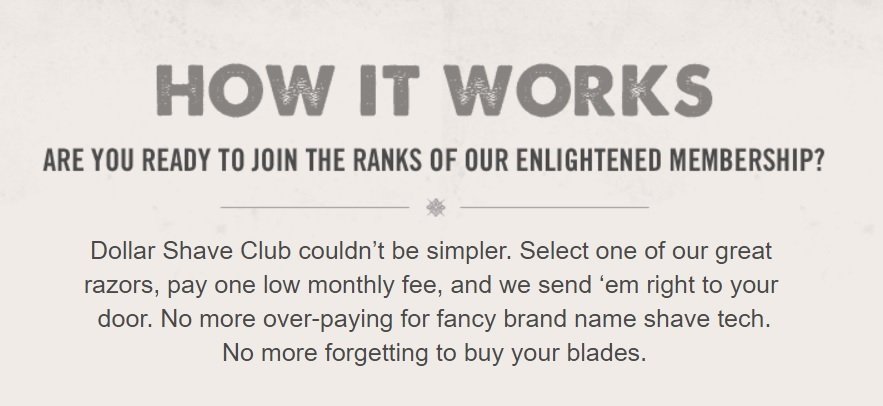Look familiar?
You might not realise it, but this is what happens every time you slash the prices of your products.
A red discount sticker is the marketing equivalent of sweeping the mess under a rug…
It’s so easy to sell more stuff with a big old 50% off sign.
But your brand’s problems remain unsolved.
At some point, you need to face up to the reality that not enough people are prepared to pay full price for your items.
I want to convince you not to take the discounting shortcut to solve your marketing problems.
Instead, you need to clean up the mess for good and start building a brand that rewards customers for paying full price for your products.
I’ve got eight strategic discount pricing alternatives to help you develop long-term profitability, and banish the evil discounting impulse to marketing purgatory.
Short On Time? Your Skim-Read Summary:
Too busy to read the whole thing? We get it: logistics, synergies, KPI’s – all that stuff. Here’s the skim read version. You really should read the whole article though…
You can click on the dot point that takes your fancy and head straight to the relevant section.
How to convey value and convince customers to buy without a discount
“For some shoppers, getting a good deal can feel like ‘a kind of buzz on steroids.’ Sales seize on ‘fun fear’ – the fear that you might miss out on a bargain, followed by a ‘pleasurable swell of excitement’ at the moment of purchase.”
— David Lewis, neuropsychologist and chairman of communications insight firm, Mindlab, speaking to The Business of Fashion.
You need to find a way to give your customers that same ‘buzz’.You need to use scarcity and urgency to prompt the same ‘fun fear’.
And you need to trigger the same ‘swell of excitement’ by convincing your customer they’ve made a great value buy without a discounted price.
If shoppers know your full price is as low as you can go, there’s no need for the bargain hunting haggle that takes place in the minds of consumers.
If you can eradicate the “could I get this for cheaper?” question from popping up in your customer’s mind – there’s no need to browse, research or compare elsewhere.
There’s no longer a compulsion to delay the purchase.
The impulse is not quashed by some rational wallet-conscious thought urging you to wait for a better deal.
If you know the item will always be full-price, you either decide to buy, or you don’t. “Maybe later” is no longer an option.
8 pricing strategy alternatives to the dangerous discount sale
If you want to maintain long term profitability, you need to earn a decent margin on your sales. There are alternatives to discounting that achieve the same result, without devaluing your brand.
I’m about to take you through eight different tactics that real, successful eCommerce brands use to reward full-price purchases and eliminate the need for regular discounting.
The next time your demand-generating reflex tempts you to slash those prices – you need to make the extra strategic effort. Find an alternative to discounting for the long-term health of your business, or risk selling your brand’s soul to the margin-gobbling devil.
#1. Price Transparency – Everlane
Do you remember that TV show called “Breaking the Magician’s Code”?
Some ghoulish looking dude in a horror movie mask takes you behind the scenes of the magic world’s most famous (and carefully guarded) secrets – breaking down the steps of each trick to explain the illusion once and for all.

Everlane is to retailers what the ghoul man is to magicians.
The business is built on a minimalist model, cutting out the middle men from the traditional retail process to reduce costs and take smaller margins. When you eliminate the need for external buyers, agents, reps, distributors, retail staff and other bricks-and-mortar overheads from the costs of a basic t-shirt – you’re left with a profitable price point far below that of your traditional retail competitirs.
Everlane designs and produces simple, high-quality products and sells direct to the customer, so you get to save without a discount.
And they prove this philosophy is more than empty marketing lip service with their ‘radical transparency’ philosophy.
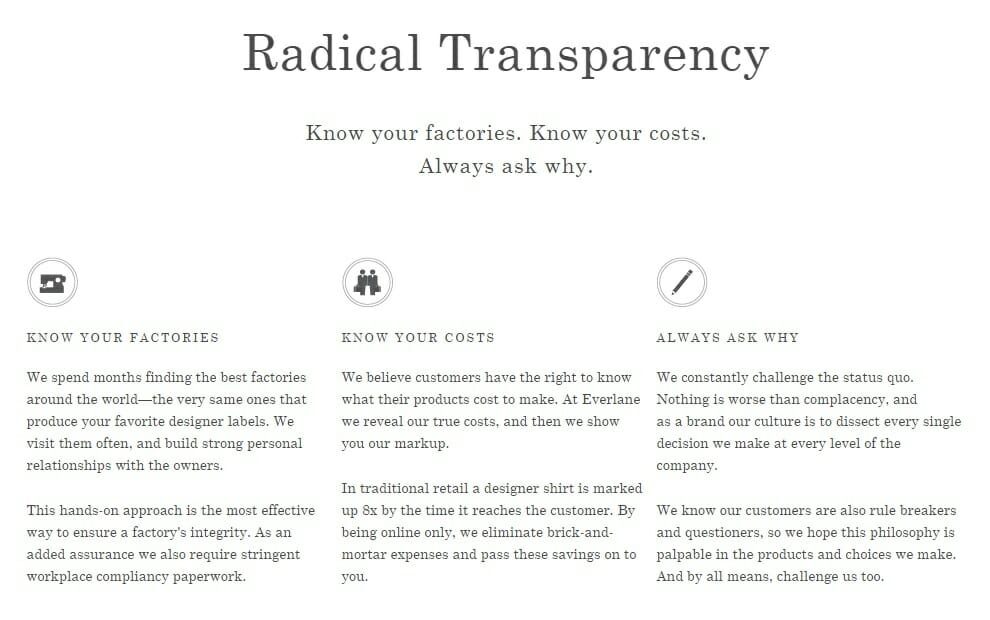
Everlane explains why they don’t need to discount.
The brand uses its content to convince customers their prices are as cheap as possible.
You can see exactly how much Everlane’s inputs cost. But the brand goes even further, contrasting their costs with those of their competitors – as you can see in this leather tote bag example:

This makes the value difference explicit and compels the customer to pay full price because it is now positioned as a discount in comparison to other options.
Laura Lorenzetti, writing for QZ, explains why Everlane doesn’t need to discount:
“To understand online retailer Everlane’s business model, you must first understand the traditional economics of retail. Customers pay for clothing in three ways: full price, somewhat discounted, or rock-bottom prices.
But Everlane never offers discounts. The price tag attached to its signature T-shirts or cashmere sweaters is permanent—or promises transparency, meaning buyers know the percentage of profit Everlane is making on each transaction. (Example: A black T-shirt sells for $15, and Everlane makes approximately $8.30 off it.) Inventories are kept lean; the goal is to sell out.”
This example from early October 2016 perfectly illustrates how Everlane’s content follows through on the transparency philosophy and convinces customers to pay full price for their products.
An email to subscribers explains why the price of cashmere sweaters has decreased from $125 to $100:
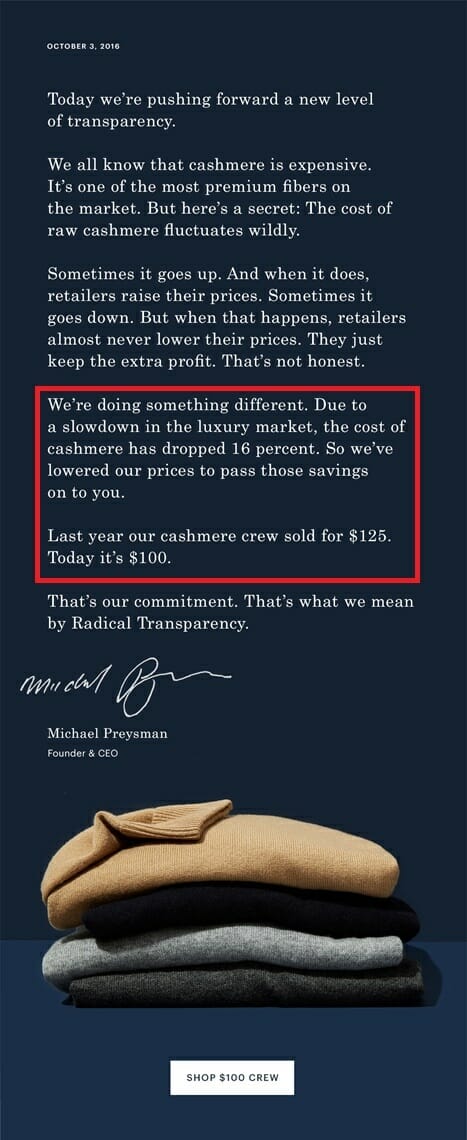
Customers know Everlane are giving you the best value possible. This content proves that Everlane sets the lowest possible price. You don’t need to shop around for a discount elsewhere because you can trust in Everlane’s value for money.
The Message To Convert Customers At Full-Price
“We’re completely open and honest about our business. We can prove that our products are the best value for money out there. We can’t discount, because our price is already as low as possible.”
The Pricing Strategy Lesson
Everlane has no stores, no advertising and no discounts.
Too many brands focus on the biggest percentage discount they can swallow without suffering a loss on each sale.
Everlane turned this model on its head.
Instead of showing value through slashed list prices, Everlane’s business model is built on minimising the full ticket price as much as possible – and communicating this to earn the trust and understanding of their customers.
#2. Limited time products – Beckett Simonon
The Beckett Simonon story is one to tape onto the locker room door of any fledgling online retail entrepreneur.
Not because of a billion-dollar valuation, or unprecedented venture capital funding.
Beckett Simonon is an eCommerce inspiration because they’ve made some major mistakes, looked failure dead in the face, and turned things around with next to no cash to build a successful brand.
Beckett Simonon success is built on the back of its innovative eCommerce business model, which is designed to make its customers excited to buy their products.
Much like Everlane, the Columbian menswear startup set out to be ‘the Warby Parker‘ of the shoe industry. They saw retailers, wholesalers, and manufacturers, all taking their cut before the shoe reached the consumer.

Co-Founder Andrés Niño explains the model to Maxim magazine:
“We were fed up with the high mark-ups that other shoes on the market were being sold for. We launched Beckett Simonon keeping quality and comfort in mind, but also with the intention of keeping prices down without sacrificing those two things.”
Andrés knew a well-crafted menswear product could be half the price. Other retailers discount because they can. There’s enough margin built into the list price that retailers can still make a profit while offering a 50%, 60% or even 70% discount. The Beckett Simonon graphic below paints a clear picture.

The Columbian-born duo at the helm of Beckett Simonon began manufacturing and selling an ever-increasing range of shoes, with a relatively standard eCommerce business model.
What they found, however, were teething problems.
Manufacturing standards were hard to control. In an effort to squash down costs, the guys manufactured through Indian contractors.
Results varied, with some customers experiencing significant problems.
Others questioned the brand’s ethical standards.
The team couldn’t keep up with demand.
After featuring in a couple of popular publications, Beckett Simonon sold out. In the rush to pump out new products loose ends started to appear and customers, frustrated with their problems, were experiencing weeks of delay before hearing a response to their inquiries.
A key decision was made.
It was time for a radical rethink.
Things had to change if the business was to succeed.
Beckett Simonon decided to rebuild its business model into a customer-crowdfunded product range. To ensure the best possible quality, at the lowest possible price, with optimal customer service – Beckett Simonon needed focus.
Here’s Nicholas Hurtado, one of the Co-Founders, who explained the new measures to a thread of irritated customers on Reddit.
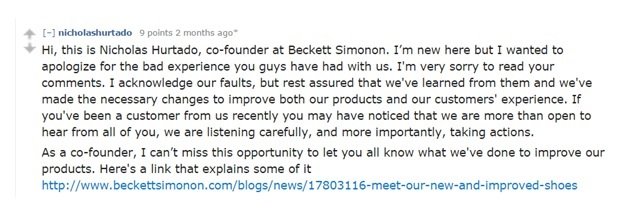
This new strategy allowed Beckett Simonon to ask customers what they wanted most, then focus on creating the best possible version of that product, with the insurance policy of a base level of presales.
Rather than offering 20 different products each season – Beckett Simonon uses its audience to select a small number of items for development.
The crowdfunding approach builds a discount into the price. Those who pledge early get the best value.
B&S explained their new approach to their subscribers in this blog article just after their re-launch:
“These new shoes are made in tropical and sunny Colombia. After manufacturing in India, we learned that responsible manufacturing is a big deal. Our new factory is family owned and operated, and our products are made with high quality and locally sourced materials.”
And why crowdfunding? We want to give you outstanding products and the best bang for your hard earned buck. Keeping inventory is a very expensive endeavour that increases the risk for ecommerce brands and traditional retailers, these costs are included in the final markup and therefore you end up paying them at the end. By avoiding these extra costs we are able to give you the best quality at an unparalleled price.”
Here’s a current crowdfunded product Beckett Simonon are focusing on (the marked down $600 price represents the traditional retail value of the product):
Beckett Simonon uses their product page content and email marketing to communicate the value of their product, prove their prices are fair, and convince their customers to pre-order the product at the listed price.
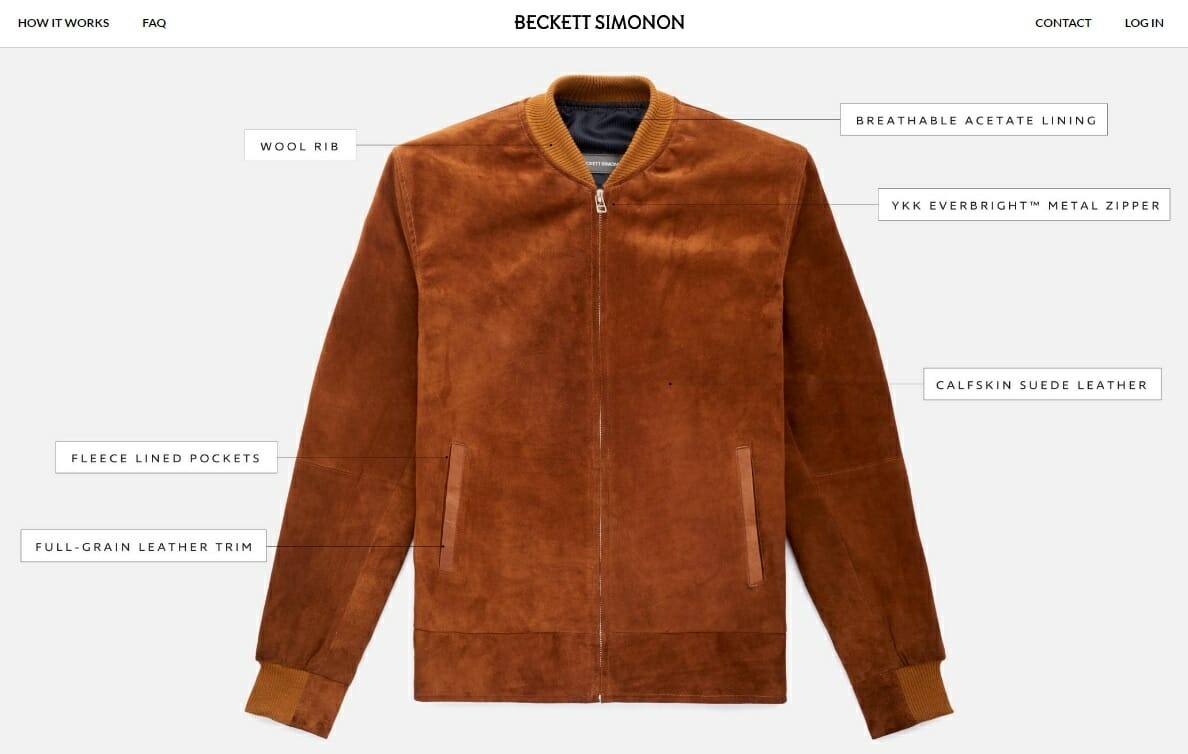
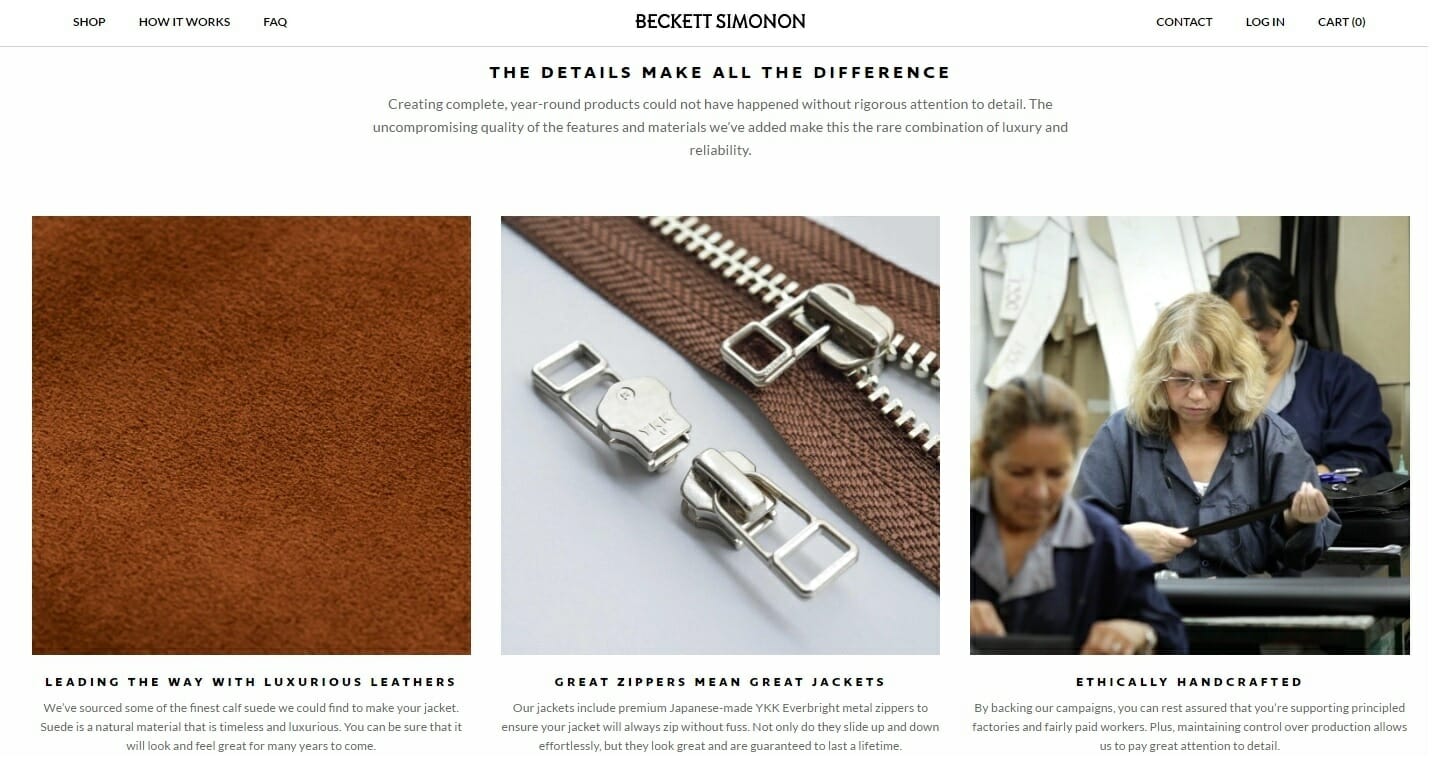
The Message To Convert Customers At Full-Price
“We only ever produce a handful of products each quarter, but when we do – we make sure they are the of the highest quality for the lowest price. We’ll ask you which products you want us to create, and in return for your choice, we ask that you pledge to pay full price – becasue you can be confident that we set a fair and valuable price.”
The Pricing Strategy Lesson
There’s a new model that helps you bootstrap an eCommerce business to fast growth.
Focus on a small number of popular items and make your version as valuable as possible.
Prove your brand’s option is the best one out there. Use your content marketing to help you crowdfund your product development.
Keeping inventory is both expensive and risky.
By asking your subscribers to choose which products you sell – you can properly forecast demand, avoid the need to discount excess stock, and provide the best possible quality for the lowest possible price.
You’ve gathered a promise from your customers to pay full price. No discounts are required.
#3. Subscription – Dollar Shave Club
There’s a beauty in the convenience of online shopping that makes subscription eCommerce an enticing option for any regular-purchase item.
DSC made the principle of convenience their core value proposition, and they used the cost-effectiveness of eCommerce to make it happen.
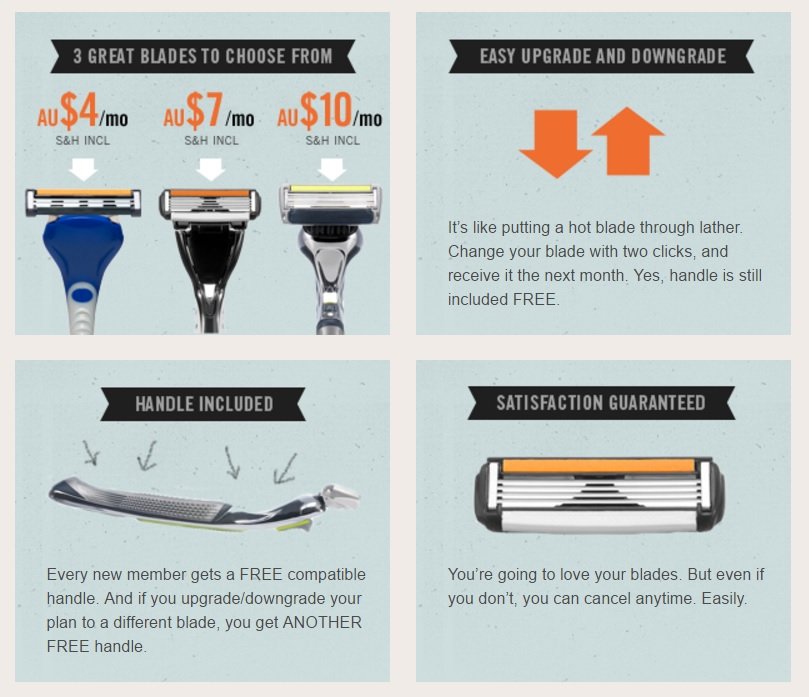
The New York Times’s Steven Davidoff Solomon explains the value proposition that allowed Dollar Shave to capture 15% of the US shaving cartridge market from the established giants Schick and Gillette – without ever offering a discount:
“The idea was rather simple. Instead of paying $10 or $20 a month at a store for disposable razors, a Dollar Shave Club subscriber could go online and set up a regular order to be shipped to his home monthly at a fraction of the retail cost.
Now it is possible to leverage technology and transportation systems that never existed before. It means that the riches will be split among the select few who have the education and skills to be at the heart of the new decentralized company.”
Gillette and Schick had engineered a near duopoly on the industry.
DSC just fixed a simple problem these two traditional brands had themselves engineered:
- The big two fought a battle to one-up with technology, as three blades became four blades and then five blades when customers didn’t really want to pay more for the fancy embellishments.
- The middlemen were taking a huge cut. And logistics expenses were significant. The blade manufacturing was a relatively small cost. Shipping the products to stores around the world is extremely expensive when compared with DSC’s direct-to-customer eCommerce model. Oh, and don’t forget the retailer needs to take its cut, further inflating the price of your Gillette razor.
- Dollar Shave Club understood its audience. 20-30 yeard old ‘bro just wants a cheap and effective razor. The simpler the transaction the better. Of course, they wanted to take 5 minutes to sign up for a bunch of $1 blades to conveniently appear in their mailbox once a month.
DSC removed the R&D, advertising, and distribution costs the big players were paying. Ecommerce allowed the brand to cut out the supermarket middle-man and sell directly to the customer.
The so-called ‘dude market’ are digital natives. They don’t watch much TV, read many papers, or listen to any radio. Instead of shelling out millions on regular advertising campaigns, DSC created their own content.
(Better yet – the subscription business model turned almost every new customer into regular, repeat sales)
Ben Thompson of Stratechery explains why The Dollar Shave Club disruption is possible for eCommerce innovators in almost any industry:
“The price difference is the entire point: in a world with good enough products (Dollar Shave Club imports their blades from Korean manufacturer Dorco) that can be bought on zero marginal cost websites and shipped to your home directly there is no reason to charge more. The Internet (and e-commerce) has so profoundly changed the economics of business that it is only a matter of time before other product categories are impacted.”
The tried and formerly true method of dominating distribution and barricading new entrants with monstrous economies of scale is ageing fast.
Ecommerce allows even the smallest of brands to disrupt the traditional retail superpowers, skip the middle-man, and go direct to the customer.
The Message To Convert Customers At Full-Price
The team at DSC have done the job for us already…
Let’s paraphrase for those of you not in the business of disrupting the ‘fancy brand name shave tech’ industry. Here’s the generic eCommerce subscription pricing message:
“Don’t worry about remembering to buy this repeatedly. Just give us your credit card details, and we’ll have it delivered to your door at the frequency you need. Because we send it direct to you, and we know exactly how many orders we have to fill – we’re able to keep our prices low and pass on the savings to you.”
The Pricing Strategy Lesson
The internet, and it’s knock-on effects, have created the perfect environment for disruption of the traditional retail business model. The bro-dude target audience of DSC was sick of travelling to the supermarket to pay $15 for a razor.
DSC came in and solved their problem for the chump change of $1, with free delivery right to their door. That was discount enough.
If you can convince someone to subscribe for a regularly delivered product – there’s no need to offer a discount. You’ve already earned the repeat sale at full price. To offer anything less would be to cheapen the value of your product in perpetuity.
#4. Freebies and extras – Surfstitch
This is your classic 2 for 1 scenario.
Buy one, get one free.
Spend a whole bunch of cash on full price items and we’ll reward you for your customers with a nice little freebie.
Discounting cheapens your brand and your product. You’re telling your customer that you can afford to sell the item at a lower price. The value of the product decreases in your customer’s eyes.
Patrick Campbell from Pricing Intelligently has a message for compulsive discounters, and it’s about as subtle as an armoured tank:
“Blindly discounting is one of the worst things you can do, because you’re conditioning your customer into de-valuing your product, and you’re literally throwing money away by putting it back on the table from the initial and future sales with that customer”
In a recent article titled “The radical retail pricing strategy to save your eCommerce profit margins”, we Gorillas outlined four ways that discounting can slowly kill your online store’s brand:
#1. You’re showing a lack of confidence in your brand
#2. You’re setting a bad precedent
#3. Your customers have a lower perceived value of your products
#4. You’re losing the trust and respect of your customers
To those dirty discounters reading this article – I’m sure you’re screaming at me about KPI’s and sales pressures.
Of course, sometimes you do need to use incentives, urgency and scarcity to drive conversions. The underlying strategy is a tried and tested retail truth.
But discounting is not the best way.
Derek Halpern of Social Triggers, explains that discounts erode brand value. Instead, retailers can add value with freebies and extras to entice purchases.
We can achieve the same results without devaluing our products with discounting.
Discounts are used by retailers for one of two primary purposes:
- to help liquidate old or excess inventory
- to amplify revenue and store traffic during holidays or events (Boxing Day, Christmas, Thanksgiving)
We can achieve both of these goals by offering a freebie as an incentive to purchase more full-priced items.
This allows you to earn normal margins on your sale, while still incentivising an urgent purchase.
Better yet – freebies don’t de-value your brand, nor do they reward the habit of waiting for a discount on future purchases.
Once again, Patrick Campbell from Price Intelligently supports our philosophy of a retail pricing strategy without discounting:
“People LOVE to get deals and feel special, but that doesn’t mean you have to cut the price. Instead, add more units, more user seats, premium service, etc. A little surprisingly goes a long way, and you won’t succumb to the long term implications of discounting. Psychologists have proven, human beings would rather receive 2 for 1 than 50% off.”
In fact, customers don’t only ascribe the same value to freebies – research suggests most shoppers perceive more value from a freebie than a discount, as this excerpt from the Receiptful blog suggests:
“Researchers from the Carlson School of Management at the University of Minnesota conducted an experiment to learn more about how consumers reacted to discounts and freebies. The conclusion was, “Shoppers… much prefer getting something extra free to getting something cheaper.”…
Almost irrationally, consumers “perceive the benefits associated with free products as higher” than their absolute value. In a paper for Marketing Science journal, Ariely found that, “People appear to act as if zero pricing of a good not only decreases its cost, but also adds to its benefits.” Therefore, retailers who price items at a cost of zero or give things away for free offer special appeal to everyday customers. We value it more, which is why so many brands take advantage of the “free gift with purchase” tactic to increase average order totals among shoppers.”
One of our favourite Australian eCommerce brands Surfstitch uses freebies to encourage shoppers to buy more full-price items.
Surfstitch has a dedicated landing page, full of coupon codes customers can enter on checkout to redeem a free gift when making a purchase over $100, or $200.

Surfstitch also incorporates the freebies offer into their product pages to incentivise upsells and increase the average cart size of their customers. You can see how Surfstitch promotes their ‘free gift’ offer in each of the red boxes below:

The Message To Convert Customers At Full-Price
“If you buy a bunch of our products, we’ll throw in a nice little freebie to encourage you to buy more at full price – both now, and in the future. The more you buy, the better your reward.”
The Pricing Strategy Lesson
Discounting may be the easy way out. You can slap on a 25% off the sticker to trigger a spike in conversions, but in the process, you’re making it more difficult to convince shoppers to pay full price in the future.
Regular discounting rewards a dangerous habit developed within the mentality of the modern online shopper – ‘if we wait long enough, we’ll get a better deal.’
Research demonstrates that your customers perceive more value in a freebie than a discount. Use 2 for 1 offer, or free gifts unlocked by a certain level of purchase. You can still increase conversions, drive more impulse sales, and get rid of excess stock – all without devaluing your product or brand.
#5. Exclusive Memberships – Field Notes
Field Notes are another Gorilla content marketing favourite.
I’m a passionate supporter of these stationary-selling superheroes. You’d be amazed how much someone could care about a simple notebook brand.
I write stuff everyday, and like many creators, I find the creative juices flow more freely onto the page than the screen. You’ll seldom find me without a notebook in my back pocket – and Field Notes is my weapon of choice.

Why do I choose Field Notes?
Sure the paper quality is great, and the materials used make these bad boys exceptionally durable. They’re US manufactured, but that doesn’t mean much to me back in Aus (apart from more expensive shipping).
I don’t buy Field Notes for the product features – I buy Field Notes because I love the brand. They believe in the same things I do. They care about crafting creative ideas. They care a quality handmade goods. They care about great design. So I pay a little extra to buy their books because I feel good while I’m using them.
The secret of Field Notes’ customer delighting lies in their breathtaking content marketing.
They make manufacturing notebooks seem magical.
Don’t believe me?
Watch and learn…
So how do these Notebook Merlin’s manage to conjure this spell of customer delight?
It’s time for an eCommerce edition of “Breaking the Magician’s Code”
It doesn’t take Harry Houdini to tell you that Field Notes aren’t using discounting to build a passionate tribe of loyal repeat customers.
The clue can be found in the word ‘tribe’.
Field Notes use a membership concept to create a community of exclusive brand fans. For an annual membership fee of $97, you get a whole collection of Field Notes’ best new release and classic products, sent directly to your door over four seasonal shipments.
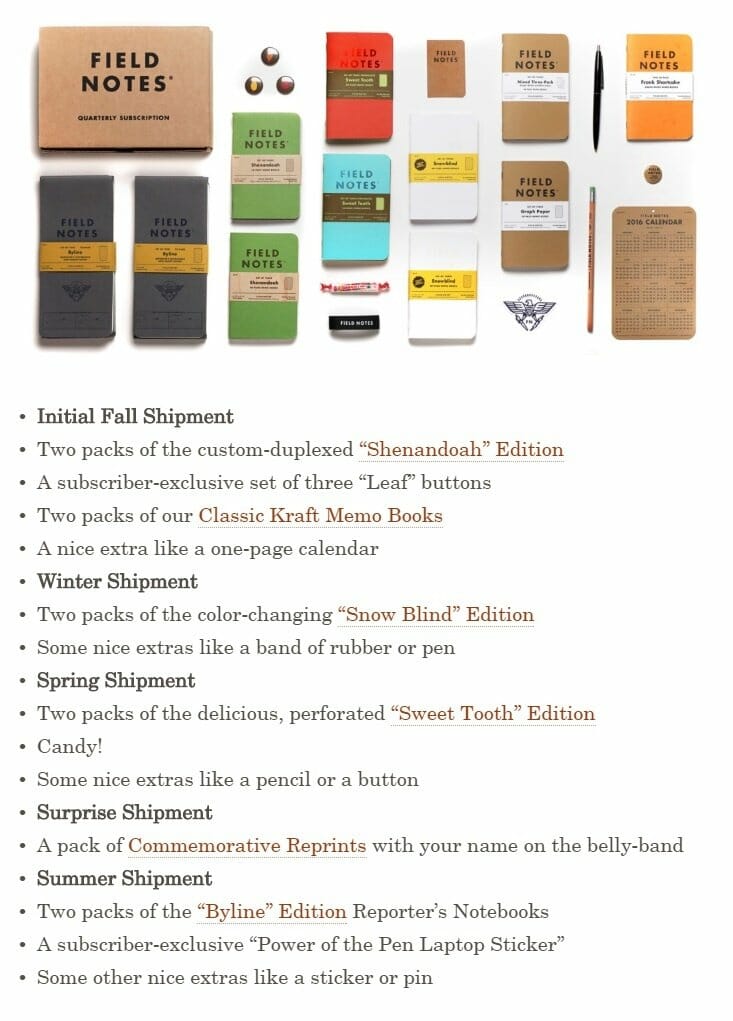
Just like your favourite, newspaper, magazine or television show, Field Notes understand that people love an ongoing segment that’s part of a larger continual story.
The membership series allows Field Notes to build an exclusive club of superfans, who are more than happy to outlay a big chunk of cash once a year in return for an exciting surprise package of gifts to lob up on their doorstep every three months.
It’s something to look forward to.
It’s something to keep coming back for.
It’s something you don’t want to miss out on.
The Field Notes ‘Quarterly Edition’ concept is a content marketing series masterpiece.
Since Winter 2008, limited edition variations on the classic memo book are released quarterly.
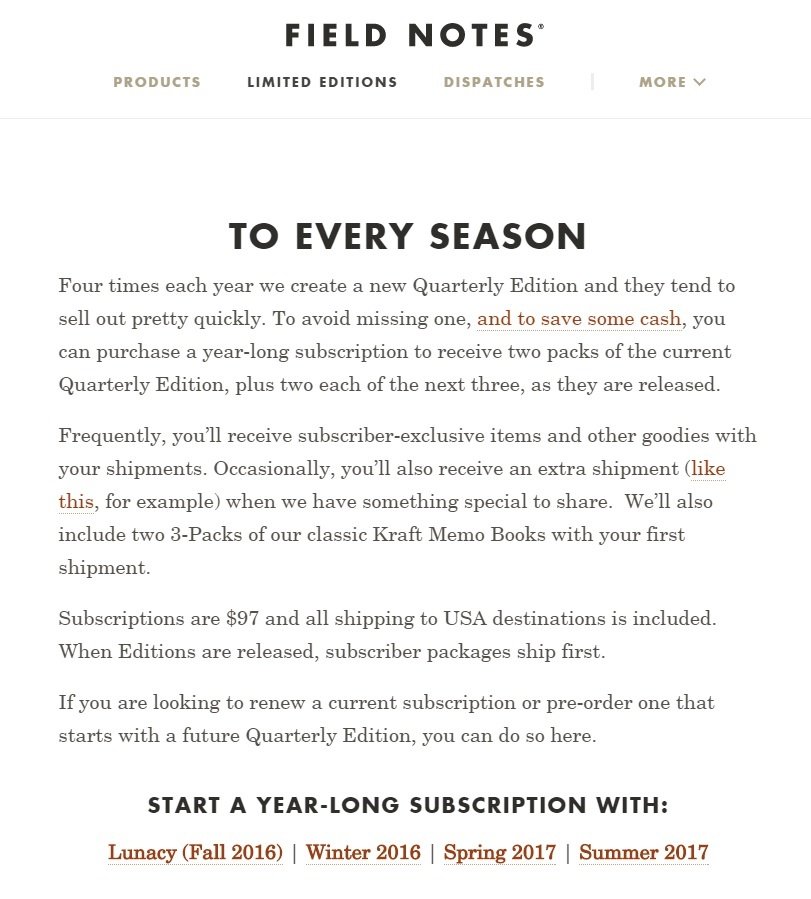
Field Notes limited editions are sold in small quantities – with guaranteed supply given to the brand’s loyal tribe of members. Small portions are avialable to non-members, but they often sell out moments after they’re released, making the membership cost or $97 so much more valuable to notebook enthusiasts who want to get their hands on the newest Quarterly Edition.
The limited-edition series explores new papers, printing processes, and colours, sometimes adding special packaging and other fringe benefits, with a new variation on a theme relating to each season.
Again, the breathtaking Field Notes video is the best way to explain:
As you can imagine, fans wait for each season’s release with unbridled anticipation.
The reveal of this video is like a beautiful gift unwrapping ceremony.
So Field Notes developed a membership model, allowing those passionate notebook nerds to avoid their FOMO, and save them from the anxiety of uncontrollable browser refreshing mayhem when the product is released to the masses.
By guaranteeing delivery of a year’s worth of new Colors notebooks, Field Notes are perfectly forecasting a baseline of demand, guaranteeing repeat purchase, and delivering their customers a quarterly gift.
What an online retail dream.
The Message To Convert Customers At Full-Price
“For an annual membership fee, we’ll send you a regular surprise package of our best new and classic products, with a bunch of exclusives thrown in that nobody else can access.”
The Pricing Strategy Lesson
No need to discount when you have an exclusive group of members paying full price for your product 12 months in advance.
Can you create an ongoing subscription-based series that keeps getting better and better and better?
Can you find a way to make your customers so excited for a new product that they pay in full before it has been released?
Can you make your exclusive tribe of members so excited about your brand they are prepared to give you their credit card details in exchange for a regular surprise package delivery?
You can.
If a notebook retailer can generate that level of excitement, you have no excuse.
#6. Scarcity – The Fifth
The Fifth is a new kid on the eCommerce block. Their range was first released in November 2014, and they’ve been selling out ever since.
How?
Scarcity.
The Fifth is selling a feeling, not a product.
It’s the feeling you get when you know you’re better than everyone else.
Because you have something desirable, enviable – exclusive.
The Fifth are selling you the chance to be a part of something special.
Only online.
Only the fifth of each month
Only for five days.
That’s the only time you can purchase one of The Fifth’s beautiful watches.
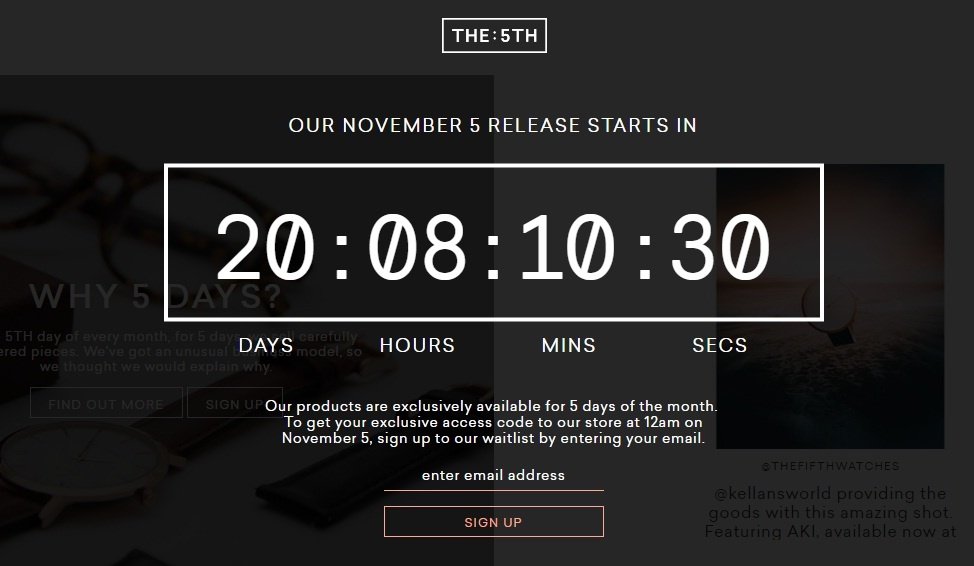
Writing for We Are The Clique, Dani Watson explains how The Fifth uses the psychological principle of scarcity to xompel users to buy (without the need for discounting):
“The Fifth Watches whole marketing ethos revolves around urgency; they release a collection of watches and there is only a certain time frame in which to buy.
On the fifth of each month, the e-commerce site is opened to customers and at midnight on the tenth, the shop is closed, until the following month. If you visit the website between those dates, a countdown pops up, revealing the time left until the next batch of merchandise, most of which costs between $100 and $200, is available.
Whatever your business, whether it be service based or you sell products, creating urgency is an amazing way of getting people to buy fast before they miss out and using Instagram to encourage this is really powerful.”
26-year-old founder Alex McBride told The Observer why the scarcity of their monthly sales window makes their pricing almost an afterthought:
“By selling each month for five days, we are able to offer that exclusive experience often associated with higher price-tag designer items at an affordable price; putting the designer experience within reach for our customers. It’s not price point that makes the 5th exclusive, its time,”
Apart from encouraging subscribers to buy without the need for a discount, The Fifth has walked into another significant strategic marketing advantage.
Because they only sell for five days of the month, the remaining 25 days are totally devoted to delighting subscribers and customers.
There’s no need for interruptive promotion or hard-selling. Instead, The Fifth concentrate their marketing efforts on delivering helpful and valuable content.
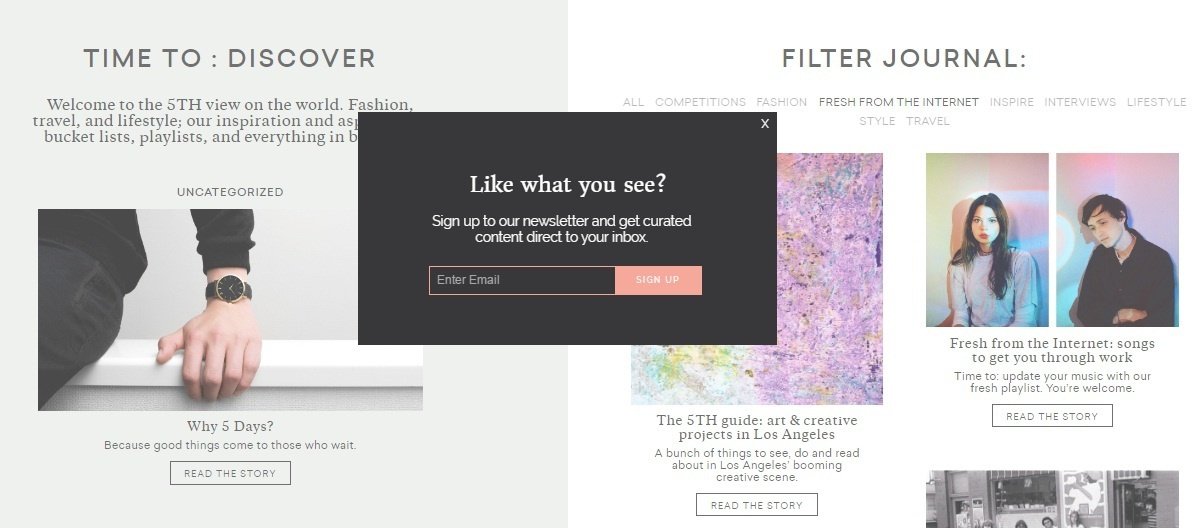
Dena Silver, writing for The Observer, explains the unexpected benefit The Fifth have derived from this innovative business model:
“Allows The Fifth to foster their relationship with the customer. For five days of each month, sales is the number one goal, the rest of the days are dedicated towards building and fostering the community that surrounds the brand.”
This business model has allowed The Fifth to grow a huge tribe of fiercely loyal followers.
Fans of the brand are excited to be a part of this new and innovative brand story. They can’t wait to tell their friends about the cool new watch they’ve bought – and the fact their friends can only get their hands on one for five days each month makes the story so much more exclusive and alluring.
Instagram and Facebook have allowed this eCommerce startup to attract and nurture a huge bunch of potential customers at a cost that barely registers in comparison to the ad budgets thrown around by traditional watch retailers and manufacturers.
Their social media marketing doesn’t need to interrupt, annoy, or persuade people – something many expensive paid advertising campaigns are guilty of in the jewellery industry.
Dena Silver outlines the genuine business results The Fifth have enjoyed from their social media community-building:
“The success of those actions can be found through the brand’s social media following, which numbers nearly half a million followers on Instagram and over160,000 on Facebook. On their busiest day of 2016, The Fifth sold 20,000 watches and they’ve accrued a waitlist of 250,000 for their various styles.”
The Fifth is able to convert a sizable chunk of these followers into paid-up brand evangelists who act as unpaid marketing ambassadors.
The Message
“We’re going to give you a limited time offer for one period each month. If you follow us on social media, or subscribe to our email newsletter, you’ll have the chance to take up the offer. Just make sure you buy before time runs out!”
The Pricing Strategy Lesson
If you can find a way to continually develop genuine excitement amongst your following, you don’t need to discount to spike demand.
Prepare regular customer surprises that are only offered for a limited time period. You’ll keep your subscribers and followers interested in your brand, and the urgency you create will be enough to convert that excitement into sales.
#7. Loyalty rewards program – Every airline/hotel brand ever
This one needs no explanation.
We all know how important frequent flyer/buyer/stayer programs are to airline/supermarket/hotel brands.
We all also understand our job’s not done after the checkout process concludes.
That’s just the beginning of a sustainable eCommerce business. The amount of one-time buyers you can convert into regular repeat customers is directly related to your long-term viability, as RJ Metrics’ 2015 Ecommerce Growth benchmark report attests.
The ‘frequent flyer’ loyalty program was first invented (in its current form) by American Airlines in 1978.
Back in the ’70s, American was not the giant presence it is today.
Its market share in the US was less than 10%, and as the sixth-largest airline brand in the country, the brand was desperate for growth.
Former CEO Robert Crandall came up with the idea of awarding existing customers for their level of loyalty with an accumulating prize. The more products (flights) you buy – the more rewards you will get. At the time, grocery chains were offering ‘green stamp’ coupons to similarly reward regular shoppers.
The rest is history – but an interesting history at that. For the astounding story behind the frequent flyer program (including the tale of a man who purchased 12,000 tubs of pudding in the quest for a lifetime of free flights), Gimlet Media podcast, Surprisingly Awesome has dedicated an entire 25-minute program. It’s a rollicking way to learn why loyalty programs work, so add this one to your to-listen list.
But it’s not just airlines that manage to increase average cart size and lifetime customer value with a simple loyalty rewards program.
Any ecommerce brand can appropriate the frequent flyer idea to their brand to help drive demand, encourage full price purchases, and reduce the need to discount.
Mark Hayes, writing for the Shopify blog, urges online retailers to take the loyalty program learnings from the tourism industry and apply it to their own niche:
“Loyalty has just begun to spread into the world of ecommerce – to date, the most common way to earn points/miles is by flying, staying in a hotel, and using special credit cards, but people are beginning to seek out online stores that offer points for all types of merchandise. Offering points to your customers will help you stand out in the ever-increasing ecommerce crowd.”
The results of effective loyalty programs speak for themselves. If you focus on nurturing existing customers into lifelong brand loyalists, you can nudge up the two of the most important metrics that determine sustainable eCommerce success.
Conversion specialist Jeremy Smith penned a valuable article explaining how eCommerce brands develop successful loyalty programs. He cites some statistics from loyalty software provider, Sweet Tooth, that demonstrates the power of the concept:
“Sweet Tooth, which creates ecommerce loyalty programs, reports that their clients gain an average year-over-year sales lift of 27%, increase the lifetime value of a customer by 40%, and see an average increase in repeat purchases of 20% — all because of a loyalty program.”
Lindsay Kolowich explores the how behind eCommerce loyalty programs in this helpful Hubspot article titled “7 Customer Loyalty programs That Actually Add Value“. Any ecommerce marketing pro should take heed of Lindsay’s advice in this critical paragraph:
“Use a tier system to reward initial loyalty and encourage more purchases. Present small rewards as a base offering for being a part of the program, and then encourage repeat customers by increasing the value of the rewards as the customer moves up the loyalty ladder. This helps solve the problem of members forgetting about their points and never redeeming them because the time between purchase and gratification is too long.
This nugget of advice pinpoints the fundamental requirement for a successful eCommerce program that rewards loyalty and discourages discount shoppers.
The Message To Convert Customers At Full-Price
“We reward you based on your level of loyalty to our brand. If you buy more, you’ll get more perks. If you buy more regularly, you’ll get more regular perks. If you spend more money with us each year, you’ll receive exponentially more reward. Just don’t expect a discount. You’ll have to join the club to get the perks.”
The Pricing Strategy Lesson
You need to find a way to encourage customers to continue to buy more full-priced items, instead of incentivising the discount-hungry bargain hunters.
Your loyal customers are your most valuable, so it makes sense to reward them more.
Try to incorporate a compounding structure. A tiered system will help you reward initial loyalty, and continue to encourage more and more full-price purchases throughout the lifetime of the customer. Gamifying the program will spark the emotions of your loyal brand fans – just make sure the rewards aren’t token, or you’ll begin to lose their respect.
#8. Social business – TOMS
Toms is built on the ‘Buy 1, Give 1’ premise.
The brand donates 1 pair of shoes to a child in need every time you make a purchase.
It’s not often you get to feel guiltless about buying a pair of shoes.
With Toms, you can.
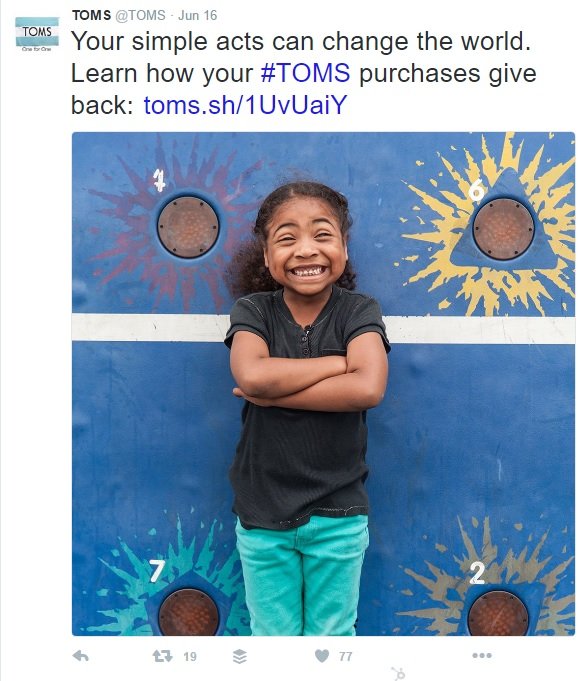
Shoe shopping spree, anyone?
Toms are dedicated to spreading a message.

They use content marketing to remind like-minded subscribers and potential customers of their genuine social commitment, and the results are unsurprising.
According to Entrepreneur, since its founding in 2006, TOMS has given away over 10 million pairs of new shoes to children in need. The eyeglasses arm of TOMS started five years later, in 2011, and has since given 200,000 pairs of glasses to those in need.
Toms’ customers love them. This strategy has built a competitive advantage so difficult to match.
When establishing a business, logically it makes sense to wait until your business is successful before donating large sums of money to charity.
Joyce Grace shares the inspirational success story behind the TOMS brand in this fantastic article:
“The company started off when owner Blake Mycoskie was traveling through Argentina and noticed that most children went without shoes and thereby were more susceptible to disease and infection. He determined to develop a company that would go against all odds and completely turn entrepreneurialism on its head: it would provide shoes for these needy children. The way he planned to fund this venture was with the ‘buy one give one’ model. The company’s view, to this day, is to send a pair of shoes to less fortunate children every time a pair of shoes is purchased.”
This business strategy resonates with a new generation of socially conscious, digitally literate buyers.
The university-educated professionals of the much-maligned ‘millennial generation also happens to be the most digitally savvy. If you’re an online store owner, it’s these socially-minded consumers who will have the cash, the skills, and the quest for convenience to regularly buy online from you.
This Blue Stout article from Akshay Sachdeva cites statistics showing that:
“more than 85% of millennials relate their purchasing decisions (as well as their willingness to recommend a brand to others) to the socially responsible efforts a company is making.
Learning how to market to millennials could position your ecommerce company as an emotionally compelling brand. This means millennials could be willing to try your product or service, and also willing to pay a higher price if necessary.”
If you can demonstrate that buying from your brand will change the world in a positive way that your audience truly cares about – you’ll have yourself a passionate group of loyal customers who will happily pay you a premium to help you serve their cause.
Joyce explains why TOMS’ charitable pledge means the type of customers they attract never need a discount to buy:
“A major strength for this company is the emotional impact that is attached to buying their product. TOMS has made making a charity donation accessible to young people without making it feel like a sacrifice. TOMS doesn’t just appeal to people who want to make a difference, it appeals to people who want to be cool and trendy too. By buying a pair of shoes, consumers can participate in giving to charity and help people at the same time. This is an enticing ‘experience marketing’ ploy that plays to people’s emotions.”
If your brand can help out those in need, integrate your social beliefs and values into your brand’s content.
Blue Stout’s Akshay Sachdeva outlines five ways to build social responsibility into your business model and make a profit while your brand stands up for what you believe in.
1. Change Your Perspective & Position Your Business Itself as A Force for Good
2. Get Involved with an Organization to be “Socially Conscious”
3. Be Transparent with Your Customers to Build Immediate Trust
4. Find a Cause to Support & Amp Up Your Content Marketing Around It
5. Turn Your New Marketing Tactics into Sales with These Tools
The Message To Convert Customers At Full-Price: To Convert Customers At Full-Price:
“We want to change the world with our business. If you care about giving back to the community in the same way we do – then please support us with your loyalty and be part of the positive change. You can be confident that your purchase will give you a quality product, and help to make a genuine social difference.”
The Pricing Strategy Lesson
If you’re serious about eCommerce niche domination, and your brand is built on a genuine social belief – prove your business is not just about the profit. Raise the industry benchmark (and your subscribers’ brand love levels), and take some inspiration from TOMS.
If you want to establish a genuine emotional connection with your subscribers, if you want a collection of repeat customers, if you want passionate brand fans prepared to pay full price for your products – you need to prove that your organisation lives by the social values your target audience cares about.
Supporting a charitable cause can help change the world and increase your profits. If this support is genuine, don’t be afraid to infuse it into your marketing. Use your content to prove your brand stands for something. Your customers will be more than happy to thank you for it with regular full-price purchases.
8 alternatives to discounting that will increase sales without slicing margins
You don’t need to discount to increase demand and run out extra stock. Don’t take the easy way out and slap a 50% off sticker on your products. The flash sale promotional barrage only serves to erode your brand’s value and eat away at your long term profitability.
There are at least eight different alternatives you can use to encourage full-price purchases, reward loyalty, and increase the average lifetime value of your customer.
- Price Transparency – Everlane
- Limited Time Products – Beckett Simonon
- Subscription – Dollar Shave Club
- Freebies and Extras – Surfstitch
- Exclusive Memberships – Field Notes
- Scarcity – The Fifth
- Loyalty Rewards Program – Every airline/hotel brand ever
- Social Business – TOMS
You have your inspiration.
If these guys can do it – you can too.
Don’t take the shortcut. It leads to a dead end.
It’s time to stop sweeping your problems under the rug and banish the dangerous discount for good.


